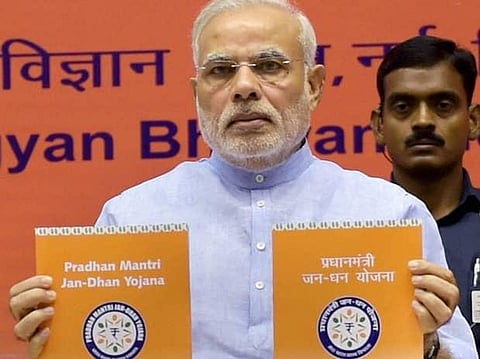
- Home
- न्यूजग्राम
- India
- World
- Politics
- Entertainment
- Culture
- Lifestyle
- Economy
- Sports
- Sp. Coverage
- Misc.
- NewsGram Exclusive
- Jobs / Internships

By Harshmeet Singh
'Mera khaataa Bhagya Vidhata', the motto of one of the most ambitious schemes of the central Government, the Pradhan Mantri Jan Dhan Yojna, depicts a picture which is far from the present reality. The Government has been patting its back highlighting that more than 14 crore bank accounts have been opened under the scheme till 31st March. But if just swelling up the number of accounts is the yardstick to measure the scheme's success, UPA's 'Swabhimaan' scheme, which saw more than 60 million accounts opening, should be called a similar success!
According to a recent World Bank report, the Jan Dhan Yojna, so far, has failed to address the biggest challenge – keeping the accounts active. Moreover, there is still no clarity over a number of 'spectacular' features that the government has been so vocal about! This gives rise to a crucial question – Is the Pradhan Mantri Jan Dhan Yojna just an empty vessel with too much noise and nothing inside? Let's dissect the different aspects of the scheme individually (including the ones not covered in the advertisements!) before we arrive at any conclusion.
Insurance at no cost. Wait! Is it?
According to the features of the scheme, every account holder would be provided with an accidental insurance of Rs 1 Lakh and a life insurance cover of Rs 30,000. This clause comes with a 'secret condition' which hasn't been mentioned in the advertisements promoting the scheme. The condition says that to be eligible for the accidental cover, you must use your RuPay debit card for a transaction at least once in every 45 days. Since the scheme majorly targets the rural population, it won't be incorrect to assume that most of the customers would lose out on this insurance due to dormant debit cards.
This insurance is attached to the RuPay debit card which would be given to the account holder. The RuPay card is a product of RBI's National Payments Corporation of India (NPCI). The insurance premium, in case of a mishap, would be payable by the NPCI. Since NPCI's earnings would depend upon the usage of RuPay card by the customers, the only way for the NPCI to compensate for the insurance premiums is to ensure that the debit cards are used frequently.
The Life insurance cover, on the other hand, has its own hidden conditions. Only the account holders with the age of above 18 and below 59 would be eligible for this insurance cover. Moreover, insurance would only be provided to the account holders with valid Aadhaar card. A number of experts also say that since the account holders aren't given any official paper guaranteeing their insurance cover, they would have a hard time in claiming the amount.
An overdraft facility of Rs 5,000! Awesome! But who pays?
One of the most talked about features of the scheme remains the Rs 5,000 overdraft facility once the account is 6 months old. According to the Government, it would depend upon the discretion of the banks to provide this facility to the account holder. The vague directions from the Government say that 'the transactions of the first six months must be satisfactory in view of the bank'
Although there were some speculations about NABARD acting as a guarantor for the funds released through the overdraft facility, there hasn't been any official confirmation in this regard.
Spare a thought for the Public Sector Banks please!
This scheme presents a precarious situation for the Public Sector Banks. Their bosses (Government) come out with populist schemes without consulting them and then question them if they fail! Although the Government directed the banks to open accounts on a zero minimum balance basis, these accounts collectively had a balance of over Rs 15,000 crore till 31st March. While this seems a bright spot at the first look, it only comes down to an average account balance of little over Rs 1,000.
The Banks require certain minimum account balance in order to recover the operational cost of the accounts. This 'minimum balance' is much more than the figure of Rs. 1,000 (Rs 10,000 – Rs 15,000 for Banking Correspondent model). In short, these accounts would put a humungous operational cost upon the already stressed Public Sector Banks. With most of these accounts remaining dormant, the banks can't be blamed for feeling hard done by the scheme.
Banking Correspondent model – Is it the right way ahead?
The most critical aspect of financial inclusion remains the 'last mile connectivity'. With less than 50,000 out of the total 6 lakh villages having a bank branch, the government has decided to go ahead with the Banking Correspondent Agent model to ensure financial inclusion.
A Banking Correspondent Agent usually earns 2% commission on every transaction, thus earning a monthly income of close to Rs. 2,000. With such low incomes and a tough job environment, these correspondents frequently give up their jobs. In fact, according to a recent survey by the RBI, almost 47% BCAs are missing from their jobs. There have also been instances where these BCAs have demanded illicit service charge from the rural customers. Such commissions are charged for a number of services including withdrawing money and loan processing. The current strength of BCAs, according to the RBI, is close to 3 lakh but their impact is still far from satisfactory. While the Government plans to increase the number of BCAs, it would also result in an increased operating cost for the Banks.
According to the 2011 census, only 59% households in India have a bank account. Considering the gloomy situation, the need for financial inclusion in the country is imperative. But launching schemes without a properly thought out framework would only give rise to disappointment on the part of the public and the Government itself.
